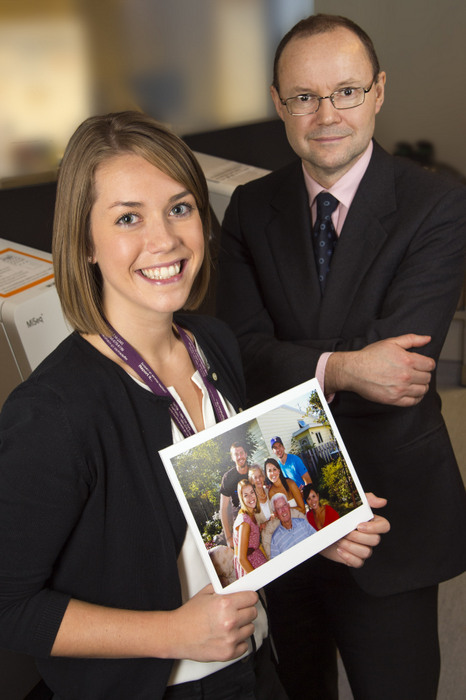
Samantha Hansford, holding a photo of her Newfoundland family, and David Huntsman. Photo courtesy of BC Cancer Agency
The master’s degree that Samantha Hansford received from UBC last spring was more than a personal academic achievement. It also represented her effort to understand the disease that has ravaged her extended family.
Her academic labours in the Department of Pathology and Laboratory Medicine, in addition to her work as a research assistant and lab technician at the BC Cancer Agency, helped illuminate the genetics of a rare but aggressive form of stomach cancer – a disease that claimed eight of her relatives over the past half-century.
That effort culminated with an article, published today in the inaugural issue of JAMA Oncology, that provides a more accurate risk assessment for individuals with a particular genetic mutation, thus giving carriers better information to guide decisions about their health – when to start screening, how frequently to be screened, and whether to undergo preventive surgery. The article also identifies 16 other mutations that may cause the disease in other families.
The new analysis found that the CDH1 mutation results in a 70 per cent risk of developing gastric cancer in men and a 56 per cent risk in women, before the age of 80. In addition, women with the mutation face a 42 per cent risk of developing a type of breast cancer. This represents the most reliable risk estimates for these mutations and will immediately influence how future families are counseled worldwide.
Hansford was a teen-ager when David Huntsman, a cancer geneticist and Professor of Pathology and Laboratory Medicine, began studying a cluster of Newfoundland families, including hers, with a history of diffuse gastric cancer. Until then, the families attributed the frequency of stomach cancer to random misfortune.
Dr. Huntsman’s work with those families led to his discovery of a mutation in a gene called CDH1 in several branches of Hansford’s family. When Hansford’s mother and uncle discovered they had inherited that mutation, they chose to have their stomachs removed – even though the risk assessment was based on a small sample of 11 families.
Hansford’s aunt was diagnosed with stomach cancer at age 34, before Dr. Huntsman’s discovery of the CDH1 mutation. Doctors removed the tumour but left part of her stomach intact to aid her digestion, inadvertently enabling the cancer to recur Five years later, it did, this time fatally. Just days before her death in 2002, Hansford’s grandmother was diagnosed with the same condition; she underwent surgery and remains cancer-free.
Hansford, after earning a bachelor’s degree in biochemistry at Memorial University of Newfoundland, asked Huntsman if she could join his lab, and perhaps help him continue his genetic detective work into the disease that plagued her family.
“I expected to be in Vancouver for six months, and wound up staying four years,” she said. “David knew I had a personal stake in this science, and helped me pursue it.”
The article, co-authored by Hansford, graduate student Pardeep Kaurah and former clinical fellow Hector Li-Chang, is based on data from nearly 4,000 individuals from 75 families in North America and Europe.
“Both my mother and my uncle had to play the odds when deciding whether to have preventive surgery,” said Hansford, who does not carry the mutation. “I wanted to help make that decision as informed as possible for others who have to make the same choice.”
“But 60 per cent of families with this disease don’t have CDH1 mutations,” she added. “I wanted to help them, too, by finding other genes that haven’t yet been connected to stomach cancer. We’re hoping that other researchers will take our findings about these other mutations and explore them further, and maybe make the same kind of definite link that David made with CDH1.
A week after the article’s publication, Hansford learned that she was accepted to the MD program of Memorial University.
The research by her and her colleagues was supported by the Canadian Cancer Society, the BC Cancer Foundation and the Canadian Institutes for Health Research.